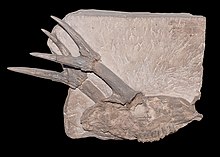277:
314:
298:
65:
526:
40:
226:
probably came from Asia, from the region where true deer are believed to have originated and evolved. It inhabited forests in the temperate belt and in Europe it was typical of the
570:
276:
313:
599:
485:
619:
609:
563:
614:
594:
297:
556:
257:
to possess them. The antlers were still quite primitive and had no tines; they were worn only by the males. Like modern deer,
51:
604:
64:
589:
373:
498:
431:
418:
472:
405:
261:
shed its antlers every year. The main stem was shorter in each new set. The same is seen in modern
59:
423:
503:
436:
286:
241:
stood 70 cm (2 ft 4 in) tall at the shoulder - the same size as the modern
540:
583:
152:
463:
536:
116:
525:
396:
533:
210:(Its name is Greek for "fork antler") is an extinct species of deer found in
76:
364:
Benes, Josef. Prehistoric
Animals and Plants. Pg. 240. Prague: Artua, 1979.
348:
457:
390:
242:
96:
490:
262:
227:
39:
30:
325:
254:
250:
215:
211:
106:
86:
367:
246:
477:
410:
289:
219:
126:
371:
544:
447:
380:
253:with a thickened base - the first known member of
564:
8:
571:
557:
368:
38:
20:
340:
272:
7:
522:
520:
14:
524:
312:
296:
275:
63:
600:Prehistoric Artiodactyla genera
620:Prehistoric Artiodactyla stubs
29:Temporal range: Middle - Late
1:
610:Fossil taxa described in 1837
543:. You can help Knowledge by
636:
519:
230:(15-5 million years ago).
615:Mammals described in 1837
595:Miocene mammals of Europe
177:
172:
158:
151:
60:Scientific classification
58:
46:
37:
23:
319:Horns from the species
16:Extinct genus of mammal
539:-related article is a
52:Natural History Museum
499:Paleobiology Database
432:Paleobiology Database
419:Paleobiology Database
303:Artist impression of
605:Miocene Artiodactyla
218:(related species in
181:D. belometchetkense
537:even-toed ungulate
449:Dicrocerus elegans
283:Dicrocerus elegans
207:Dicrocerus elegans
162:Dicrocerus elegans
552:
551:
514:
513:
374:Taxon identifiers
249:sported a set of
203:
202:
147:
627:
590:Prehistoric deer
573:
566:
559:
528:
521:
507:
506:
494:
493:
481:
480:
468:
467:
466:
440:
439:
427:
426:
414:
413:
401:
400:
399:
369:
357:
356:
345:
316:
300:
279:
145:
138:
68:
67:
42:
21:
635:
634:
630:
629:
628:
626:
625:
624:
580:
579:
578:
577:
517:
515:
510:
502:
497:
489:
484:
476:
471:
462:
461:
456:
443:
435:
430:
422:
417:
409:
404:
395:
394:
389:
376:
361:
360:
347:
346:
342:
337:
330:
323:(now placed in
317:
308:
301:
292:
280:
271:
236:
168:
165:
144:
136:
62:
33:
27:
17:
12:
11:
5:
633:
631:
623:
622:
617:
612:
607:
602:
597:
592:
582:
581:
576:
575:
568:
561:
553:
550:
549:
529:
512:
511:
509:
508:
495:
482:
469:
453:
451:
445:
444:
442:
441:
428:
415:
402:
386:
384:
378:
377:
372:
366:
365:
359:
358:
339:
338:
336:
333:
332:
331:
318:
311:
309:
302:
295:
293:
281:
274:
270:
267:
235:
232:
201:
200:
199:
198:
193:
188:
183:
175:
174:
170:
169:
166:
156:
155:
149:
148:
134:
130:
129:
124:
120:
119:
114:
110:
109:
104:
100:
99:
94:
90:
89:
84:
80:
79:
74:
70:
69:
56:
55:
44:
43:
35:
34:
28:
15:
13:
10:
9:
6:
4:
3:
2:
632:
621:
618:
616:
613:
611:
608:
606:
603:
601:
598:
596:
593:
591:
588:
587:
585:
574:
569:
567:
562:
560:
555:
554:
548:
546:
542:
538:
535:
530:
527:
523:
518:
505:
500:
496:
492:
487:
483:
479:
474:
470:
465:
459:
455:
454:
452:
450:
446:
438:
433:
429:
425:
420:
416:
412:
407:
403:
398:
392:
388:
387:
385:
383:
379:
375:
370:
363:
362:
354:
350:
344:
341:
334:
328:
327:
322:
315:
310:
306:
299:
294:
291:
288:
284:
278:
273:
268:
266:
264:
260:
256:
252:
248:
244:
240:
233:
231:
229:
225:
221:
217:
213:
209:
208:
197:
194:
192:
189:
187:
184:
182:
179:
178:
176:
171:
164:
163:
157:
154:
150:
143:
142:
135:
132:
131:
128:
125:
122:
121:
118:
115:
112:
111:
108:
105:
102:
101:
98:
95:
92:
91:
88:
85:
82:
81:
78:
75:
72:
71:
66:
61:
57:
53:
49:
45:
41:
36:
32:
26:
22:
19:
545:expanding it
531:
516:
448:
381:
352:
349:"Dicrocerus"
343:
324:
320:
304:
282:
258:
238:
237:
223:
206:
205:
204:
195:
190:
185:
180:
167:Lartet, 1837
161:
160:
153:Type species
146:Lartet, 1837
140:
139:
117:Artiodactyla
47:
24:
18:
534:prehistoric
321:D. furcatus
285:Collection
245:. Its long
234:Description
196:D. salomeae
191:D. grangeri
584:Categories
382:Dicrocerus
335:References
305:Dicrocerus
259:Dicrocerus
239:Dicrocerus
224:Dicrocerus
186:D. elegans
141:Dicrocerus
48:Dicrocerus
25:Dicrocerus
464:Q18646594
83:Kingdom:
77:Eukaryota
458:Wikidata
397:Q1002774
391:Wikidata
263:muntjacs
243:roe deer
173:Species
127:Cervidae
123:Family:
107:Mammalia
97:Chordata
93:Phylum:
87:Animalia
73:Domain:
491:5936148
478:4446645
411:4446644
269:Gallery
255:cervids
251:antlers
228:Miocene
133:Genus:
113:Order:
103:Class:
50:skull,
31:Miocene
424:395208
353:Biolib
326:Euprox
287:Lartet
216:Europe
212:France
532:This
504:64180
437:42668
247:skull
541:stub
486:GBIF
290:MHNT
220:Asia
473:EoL
406:EoL
222:).
586::
501::
488::
475::
460::
434::
421::
408::
393::
351:.
329:).
265:.
214:,
54:.
572:e
565:t
558:v
547:.
355:.
307:.
159:†
137:†
Text is available under the Creative Commons Attribution-ShareAlike License. Additional terms may apply.



